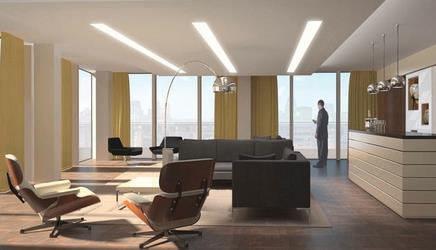Josephine Smit asks some of the industry’s leading experts
Today’s workplace can take many forms, and interiors are constantly evolving, with changes in design styles, the introduction of new business technologies and construction materials and smarter ways of working. Add to this the present economic pressures on businesses and tomorrow’s workplace interior could look very different to today’s.
Through the boom years businesses were happy to invest heavily in creating and regularly updating their office interiors. With today’s downturn, there may be concerns that spend and innovation will both be severely constrained.
The good news is that that high-quality, innovation-packed interiors are integral to tomorrow’s businesses. But an era of spending without having to consider the cost is at an end. Environmental concerns are impacting on interior design and the materials and technologies going into the modern office. Communications technology is increasingly taking the place of those environmentally unsound business trips. Lavish surplus square footage may also be regarded as profligate in a tougher economic climate.
For more workers “the office” may no longer be a fixed location. But that does not mean that the death of the HQ is imminent. A physical representation of an organisation’s culture and ethos will remain a feature of business life and its future is looking good, as the experts here predict.
The way we use offices is being revolutionised by latest advances in video conferencing. Now you can collect teams around the world and feel like you are in the room together.
Vincent Clancy, CEO, Turner & Townsend
The next big innovations are all in lighting. We are only just beginning to see the impact of LEDs but I’d love to see the development of large flat panels that emit low glare light.
Tim Quick, director, Formation Architects
We’ll have 3D meeting rooms with projected holographic images of people. People say there are times when you need to see the whites of the eye – well, you’ll be able to.
Richard Beastall, TP Bennett
Technology has allowed the office to break free of the constraints of architecture. But people will always need to come together in buildings, and this is where the real opportunity for innovation lies – in the creation of truly flexible buildings designed to accommodate global corporations seeking individuality and a competitive advantage through real estate.
Nick Pell, principal, Swanke Hayden Connell International
The focus of the future workspace will be on flexibility and sustainability. Occupiers will look at embracing advanced ways of working. This will see desk sharing and home working – even in traditional industries. It will allow organisations to work in an increasingly sustainable way.
Helen Berresford, partner, head of ID:SR
We will see a return to functional and efficient space, with less time for distracting gimmicks and frippery.
Phil Hutchinson, joint managing director, BDGworkfutures
In time I think there will be sleeping rooms in the workplace – acoustically sealed, of course.
Grant Kanik, Gensler
Creating relationships with suppliers who want to offer differentiated services to our clients delivers the value, innovation and surety of supply needed in today’s tight commercial environment.
Andrew Tuck, head of European operations centre, EC Harris
Interiors are increasingly drawing inspiration from the pre-electric offices, mills and factories of the industrial revolution that had no option but to maximise the use of natural energy sources for lighting and cooling. Today, large windows, light wells, natural ventilation, etc, are just as effective in reducing energy requirements.
Adaptable interiors are not new but this principle is now being taken ever further with public, commercial and residential spaces being interwoven to create ultimate flexibility… and reduced energy consumption.
Terry Keech, sustainability partner, calfordseaden
The recent trend has been the realisation that the most important asset a company has is its people, and in defining space to attract the best. There’s been a talent war and interiors have played a key part in that. That will continue even in a recession.
But some realities will have to be confronted, and one is how badly we use space. We’ve just found that the office of one client of ours is empty half the time. When you are making lots of money that might not be a concern, but in a recession can you afford to leave space empty? We are now seriously into the real world.
Jack Pringle, partner, Pringle Brandon
We foresee the convergence of multiple typologies. Workplace, hospitality, retail and education sectors are blending to such a degree that in the future they may well be indistinguishable from one another. Offices will increasingly have a residential feel… Hospitality design will continue catering to the business traveller, making the hotel a branch office…
Brian Szpakowski, associate director, Broadway Malyan
Inside Story 2008

- 1
- 2
- 3
- 4
- 5
- 6
- 7
- 8
 Currently
reading
Currently
reading
What is the future for fit-out?





































No comments yet